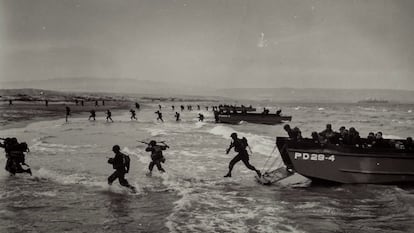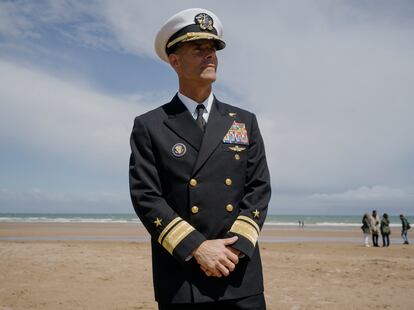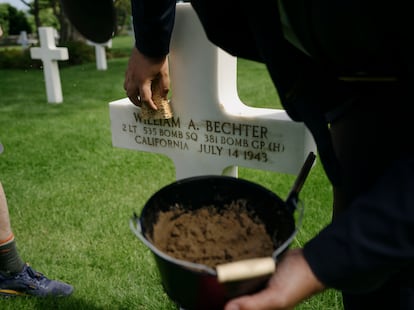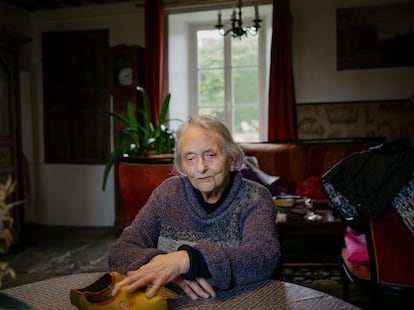Europe and the US commemorate D-Day (and suddenly World War II no longer seems so remote)
The 80th anniversary of the Normandy landings, with very few surviving veterans, takes place at a time when transatlantic unity is in danger


D-Day. So far away in time, and yet so close at the same time. Here, on the beaches of Normandy, the past is almost physical: the same fine sand, the changing tides, the sky, now blue, now rain-filled, and the wind. But the past does not let itself be trapped: how can we really begin to imagine what happened on this very spot on the morning of June 6, 1944?
Eighty years have passed since 130,000 mostly American and British soldiers landed on the shores and contributed, together with the Red Army on the eastern front, to liberating Europe from Nazi Germany. Few survivors remain. Memory is fading. The Normandy landings belong to history books and movies.
And yet, rarely has that past been so present, as if the images of the battles on Omaha Beach and the other sandbanks — the fire, the blood, the ruins, and the cemeteries — are no longer something as remote and intangible as they were perhaps 10, 20, or 30 years ago. With Russia’s invasion of Ukraine, war has returned to Europe.
— My father never told us about what happened that day.
María Palacios recounts a story she only discovered as an adult. Her father’s name was Alfredo Palacios and he revealed little of what happened to him in the very place where María stands now. In addition to relatives of the D-Day soldiers, local authorities and U.S. and French military commanders are in attendance. Hymns are sung, speeches are made. A monument to the U.S. Navy Special Forces who fought that day has just been unveiled, those who landed on Omaha Beach; the forebears of the Navy Seals who in 2011 located and killed Osama bin Laden in Pakistan.

Omaha, the best-known of the Normandy landing beaches, “dominated by promontories covered by halophytic plants [that] became a far deadlier target than the Allies had expected,” recounts historian Antony Beevor in his monumental The Second World War. “The first wave of invaders suffered very heavy casualties, victims of machine-gun fire and enemy light artillery, which riddled the landing craft as soon as they descended the ramps.” On D-Day, 4,414 Allied soldiers were killed and between 4,000 and 9,000 Germans were listed as killed in action, wounded, or missing, according to an Associated Press estimate.
María Palacios has come from California with her family to Omaha Beach, where her father, Alfredo, lost his left arm.
— He was at the bottom of the ravine, weak and tired.
Alfredo was 26 years old, of Mexican origin. He was finishing his engineering studies when he enlisted in the Navy. June 6, 1944 was short-lived for him: wounded, he was evacuated to the other side of the English Channel. Returning to the United States, he met María’s mother and worked as an engineer for the California State Department of Inspections. He inspected buildings, factories, bridges... His daughter recalls that he was also in charge of the Golden Gate Bridge in San Francisco: “He would climb the bridge, with one arm.”
Alfredo Palacios died in 2015, at the age of 95. “He wanted to make it to 100,″ sighs his daughter. “I would have liked to be here with him.”
There are fewer and fewer veterans remaining. “There’s not a single one left,” said one of them in 2014, living proof that there was at least one left. His name was Walter Heline, and he received EL PAÍS in his modest house on the outskirts of Baltimore. He had enlisted at the age of 19. He had never seen combat before he set foot on Omaha Beach. He said that unlike his country’s wars this century — Iraq, Afghanistan — soldiers knew then what they were fighting for. “Not now,” he lamented a decade ago, when Russia had launched its first invasion of Ukraine in the Donbas region and the old European order was beginning to crumble. Six years later, in May 2020, the Baltimore Sun newspaper broke the news: “Walter W. Heline, an Army ranger with the 29th Division on Omaha Beach on D-Day, has died.”

On the 80th anniversary of D-Day, some of the last survivors of this heroic and dwindling community — the greatest generation, they call them at home, the one that gave the United States perhaps its last definitive and glorious military victory — will travel to Normandy. They are all aged around 100 and it is likely that for the 90th anniversary there will be only a handful left. On Thursday June 6, they will take part in ceremonies alongside French President Emmanuel Macron and his U.S. and Ukrainian counterparts, Joe Biden and Volodymyr Zelenskiy. Russia has not been invited.
— Is this the last time?
Dominique Moïsi, essayist, author of The Geopolitics of Emotion and Norman by adoption, asks this question in a double sense. The first concerns the age of veterans: “Will this be the last time in its biological meaning?” The second, to the dangers lurking for the alliance between the United States and Europe, an alliance whose founding hour — its crowning hour — was D-Day. And here the question also refers to the upcoming U.S. elections: “Will Europe continue to be of interest to America if Donald Trump is elected president in November?”
Moïsi has attended every commemoration for the last 40 years and there has always been a topical undercurrent, from the Cold War in 1984 to the annexation of Crimea in 2014 to the Balkan or Iraq wars. But never more so than now, he says: “War has returned to Europe, and the Colleville-sur-mer cemetery with the graves of soldiers fallen for freedom evokes the cemeteries in Ukraine with soldiers fallen not only for the defense of their country, but for the defense of freedom.”

The ceremony comes three days before the European elections and with a host, Macron, who has warned: “Our Europe may die.” It comes five months before a U.S. election that may be won by Trump, the former president and candidate who threatens to leave Europeans helpless in the face of the Russian threat. It is being celebrated — if celebrate is the right word — with an open war in the Middle East and decisive moments for Ukraine, which is facing a new Russian offensive and doubts about the effectiveness of Western aid, and its viability if Trump wins.
“For the first time, the past evokes the present and threatens to foreshadow the future,” Moïsi says. “For now, the only young people to die for the cause of freedom are Ukrainians. What would happen tomorrow if the conflict were to widen?”
Captain Rick Woolard, a former Navy Seal and Vietnam veteran, has come to Omaha Beach to unveil the memorial to his predecessors and after a brief speech he asks: “What they did then, could we do now?” When asked to respond, he says: “I don’t have the answer. I just hope we don’t have to find out.” He is alluding to the 1930s, a decade of totalitarianism and preparation for World War II: “It’s 1938, everybody is afraid that something will happen, hopefully not, but the possibility is there. Thirty years ago, the USSR collapsed and we thought there would be peace, love and happiness forever. And here we are now.”
“Where do we find people willing to risk it all, to give it all for something greater?” says Rear Admiral Keith B. Davids, commander of U.S. Navy Special Forces, looking out over the beach. “This inspires us today.”
This is, for many, a sacred place, and a place of pilgrimage. Like the Burridge family, from Chicago, who gather at the grave of Wiliam Bechter, a pilot who was shot down in July 1943 farther north, near the Belgian border. Bechter was the uncle of a family friend. He was 22 years old.
After the ceremony, during which they planted a small U.S. flag and some French ones, they sent the photo to their friend, who lives in Denver. “Unbelievable!” he replied immediately. Richard, the father of the family, is moved standing between the thousands of crosses and the sea: “We have come to honor what these guys did to change the course of history and allow us all to have a freer life.”
You have to drive a few kilometers inland, to Caen or Saint-Lô, to come across an urban landscape that is common in this part of France: that of ugly post-war architecture, the after-effect of cities bombed by the Allies in the months leading up to D-Day and in the days that followed. A total of 60,000 civilians died, according to estimates by historian Stephen A. Bourque, author of Beyond the beach. The allied war against France. Saint-Lô, where Macron will participate Wednesday in a ceremony, was 90% destroyed: a field of ruins.
Memories overlap in Normandy. And that of the bombing of the civilian population is among the most complex, because those who bombed were the liberators. “A war crime,” according to Bourque.

On the way back to the beaches, at the farm of Paulette and Bernard Petit, who were children on D-Day, you will hear only words of gratitude for the U.S. soldiers who liberated them. Another memory.
Paulette remembers the morning of June 6, 1944. She was nine years old. The family lived half a mile from the beach. They hid in a ditch. “It was then,” she says, “that we started to hear a huge, huge, huge noise... Soldiers were shouting. My dad told me: ‘They’re fighting with knives.” The next day they saw convoys pass by and someone said: “That’s it, they’ve arrived.” “A soldier gave us chocolate bars and cigarettes,” says Paulette. “I smoked a cigarette and got sick. I never smoked again.”
— Were you ever afraid in those days?
— When you’re nine years old, you’re not afraid. You can’t die at that age.
Sign up for our weekly newsletter to get more English-language news coverage from EL PAÍS USA Edition
Tu suscripción se está usando en otro dispositivo
¿Quieres añadir otro usuario a tu suscripción?
Si continúas leyendo en este dispositivo, no se podrá leer en el otro.
FlechaTu suscripción se está usando en otro dispositivo y solo puedes acceder a EL PAÍS desde un dispositivo a la vez.
Si quieres compartir tu cuenta, cambia tu suscripción a la modalidad Premium, así podrás añadir otro usuario. Cada uno accederá con su propia cuenta de email, lo que os permitirá personalizar vuestra experiencia en EL PAÍS.
¿Tienes una suscripción de empresa? Accede aquí para contratar más cuentas.
En el caso de no saber quién está usando tu cuenta, te recomendamos cambiar tu contraseña aquí.
Si decides continuar compartiendo tu cuenta, este mensaje se mostrará en tu dispositivo y en el de la otra persona que está usando tu cuenta de forma indefinida, afectando a tu experiencia de lectura. Puedes consultar aquí los términos y condiciones de la suscripción digital.
More information
Archived In
Últimas noticias
Rowan Atkinson tops Netflix at 70: ‘He’s as funny as ever’
Israeli recognition of Somaliland stirs up the Gulf
Tiger Woods turns 50: Will he continue playing on the PGA Tour or take a back seat?
The surreal journey of James Nnaji, the Barcelona youth player selected in the NBA Draft who ended up in the NCAA
Most viewed
- Oona Chaplin: ‘I told James Cameron that I was living in a treehouse and starting a permaculture project with a friend’
- Reinhard Genzel, Nobel laureate in physics: ‘One-minute videos will never give you the truth’
- Sinaloa Cartel war is taking its toll on Los Chapitos
- Why the price of coffee has skyrocketed: from Brazilian plantations to specialty coffee houses
- Chevy Chase, the beloved comedian who was a monster off camera: ‘Not everyone hated him, just the people who’ve worked with him’










































